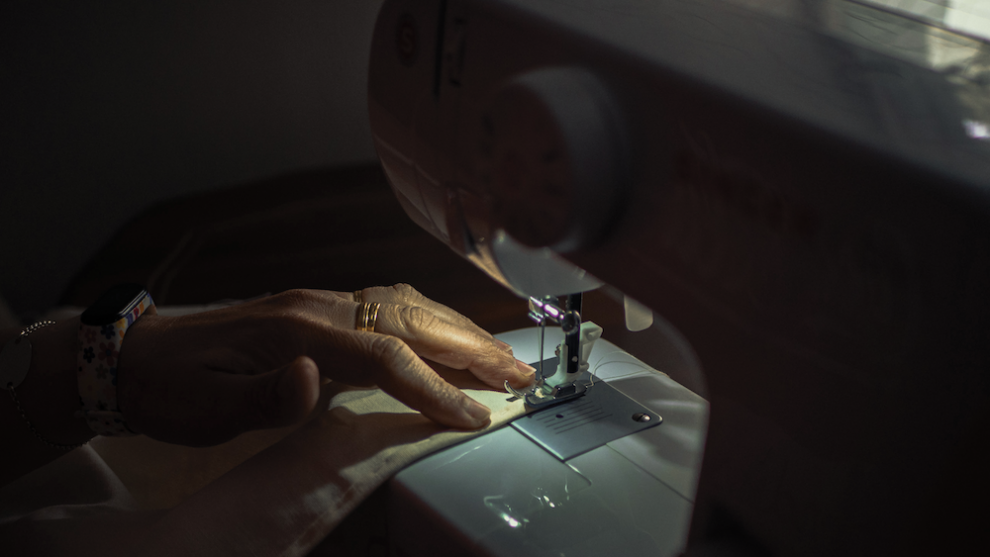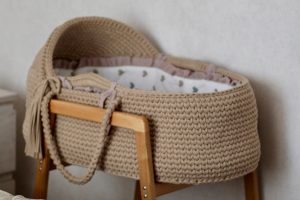Forty years ago, my mother gave me a ragged patch-work quilt made of earth-toned wools—warm except where it was moth-eaten or worn through. I first used it as a bed covering in a cold New Jersey apartment but eventually repurposed it.
From a crowded closet I pulled out the electric Singer sewing machine I’d salvaged from my maternal grandmother’s estate sale. Manufactured in 1948, the workhorse—round, wooden case, sleek and sorrel—was already a relic. No bells and whistles. Stitch forward, stitch backward. Portable and beautiful, but at 40 pounds it was nearly impossible for me to lug across a room. But I did.
I pinned pieces from a commercial pattern, cut, crafted, and stuffed a teddy bear, even reusing the quilt’s lumpy batting. To me, he was charming and comforting, though from the start his head drooped forward like a crooked, old man.
I proudly showed Mr. Bear to my mom, who gasped: “What? Didn’t you know? That quilt was pieced and tied by your father’s grandmother!” To make amends, I cut out and puffed up a bear for my parents. Having honed my skill and invested in fiberfill, I fashioned more for siblings. When I’d depleted the quilt, I turned to an old, ecru, wool blanket.
For decades, the bears have graced their homes. One slept in a doll’s cradle. One guarded a fireless hearth. Mine sat, head bowed as if in prayer, in a toy high chair at the end of an upstairs hallway.
Then the virus hit, and newscasters aired stories of teddy bears set in windows to encourage neighborhood children. My brother sent me a photo—his teddy sporting a ribbon necktie, standing tall in his front-room window. “Bear finally has a purpose in life,” he wrote. I forwarded that picture to others—who similarly moved their old bears for street-side display.
Newly inspired, I brushed mine off and propped him up at the dining room window, his black-felt nose leaning against the glass. Although he was supposed to bolster beleaguered pedestrians, the front shrubbery blocked the view. I’m not sure anyone has noticed.
◆ ◆ ◆
There is no action so slight . . . but it may be done to a great purpose . . . nor is any purpose so great but that slight actions may . . . help it much, most especially that chief of all purposes, the pleasing of God. —John Ruskin
When we were asked to stay home and to wear masks if we ventured out for essentials, I cleared off the dining room table and oh-so-carefully set up my Singer, its chestnut backside now scarred. A decade ago I lost my grip and dropped the behemoth. The fix-it shop could repair the machine but not the gashed casement.
From old suitcases I pulled fabric remnants and notions and yardage bought for God-knows-what. I particularly noted some five yards of rough muslin I’d snatched up in the final hour of a friend’s estate sale. (I didn’t have a plan, but I couldn’t bear to see it being tossed aside.) A biblical aphorism—Mordecai to Queen Esther—now came to mind: “Who knows? Perhaps you have come . . . for such a time as this” (Esther 4:14). I fashioned a muslin mask for myself and a score more to send to family and friends.
Then a sudden full stop. The motor hummed, but the threading halted. Across the table I discovered the snapped belt that had tied the Singer together.
Thanks to find-and-replace research by a thoughtful friend, within 10 days I was back at the task, this time tearing strips from discarded curtains as if I were Scarlett O’Hara. I’ve made 40 masks so far, all from repurposed materials.
It is solitary, housebound work—me and the Singer that belonged to my grandmother who survived the Spanish flu, a Depression foreclosure, and marriage to a difficult man. I imagine her fortitude driving the fast thunk-a-thunk of the needle.
◆ ◆ ◆
As a girl I attended the funeral of a neighbor, a tall, straight, old man who cared for his wife and rarely went out of his yard. The homilist quoted blind John Milton: “They also serve who only stand and wait.” A child of workaholics, I puzzled at this. It marked my memory and makes more sense to me now.
Service—useful purpose—comes in many forms.
Emergency and medical workers have been risking their lives. Truckers and store stockers have been lifting heavy loads. Educators have stretched their capacity to reach students. Others of us can and do find new purpose, even if sequestered at home.
My friend Roberta, confined and visually impaired, complains of boredom; the pastor asks her to pray for the parish, her neighbors, the world. My friend Mary phones David, who has no local family and lives in a care facility. My neighbor hands me home-cooked meals now and then—I don’t know, maybe in exchange for my cloth masks.
I made a few more today. And as I sew, there, precariously perched in the window near my left shoulder, sits my no-neck teddy. From the corner of my eye, I see his patchwork back, pieced from a farm family’s winter wardrobe. He steadily gazes across the creek run to the far knoll, and I realize his purpose is not to amuse passersby.
Those who draw our spirits up and out, beyond our domestic landscapes, to the horizon and heavens also serve—and there our true and ageless help and hope.
This article also appears in the July issue of U.S. Catholic (Vol. 85, No. 7, pages 19-20). Click here to subscribe to the magazine.
Image: Unsplash.com/Jose Pedro Ortiz













Add comment